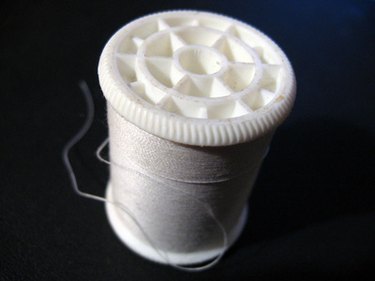Things You'll Need
Seam ripper
Thread
Scissors
Elastic tape
2 safety pins
Straight pins
Sewing machine

Elastic waistbands allow flexibility for a snug fit. If the elastic breaks or fails to provide the correct fit, then replacing or removing part of the elastic may work. Adding a new section of elastic tape can extend a small waistband and reduce discomfort. Removing a section of elastic can reduce a large waistband and prevent sagging.
Opening the Casing
Step 1
Open the casing stitching with a seam ripper on the wrong side of the garment in an inconspicuous place. A gap of approximately three inches should allow you to insert your fingers. If the elastic can freely move through the casing tunnel, use your forefinger and thumb to pull the elastic out of the gap until an overlapping section shows the two elastic ends stitched together.
Video of the Day
Step 2
Remove the reinforced stitching from the overlapping tape ends with the seam ripper.
Step 3
Attach a safety pin to one end of the tape. Secure this tape to the garment to prevent the tape from being lost in the casing. Repeat this step for the other elastic end.
Adding Elastic
Step 1
Cut the extension of new elastic tape with scissors.
Step 2
Remove one of the safety pins from one tape end. Overlap the new elastic to one end of the old elastic in a half-inch section. Pin the two pieces together with a straight pin to keep them in place.
Step 3
Place the overlapped elastic pieces on a sewing machine's needle plate. Select a zigzag stitch from the machine's pattern selector. Remove the straight pin.
Step 4
Machine stitch the overlapping section. Back-stitch over the first line of stitching. This machine stitching helps reinforce this overlapped section. Take care that the stitches do not catch onto the garment.
Step 5
Repeat Steps 2 to 4 to attach the remaining elastic end with the new section. A longer elastic loop should form.
Reducing Elastic
Step 1
Remove one safety pin from one elastic end. Cut off a section of elastic to reduce its length.
Step 2
Remove the safety pin from the other elastic end. Take care that the elastic does not recede into the casing. Overlap the two elastic ends in a half-inch section.
Step 3
Place the overlapped elastic pieces on a sewing machine's needle plate. Select a zigzag stitch from the machine's pattern selector. Remove the straight pin.
Step 4
Machine stitch the two elastic pieces together by forming a line stitch, then back-stitching over the original stitches. This machine stitching helps reinforce the overlapped section. The stitches should not catch onto the garment. A smaller elastic loop will form.
Finishing
Video of the Day
Step 1
Work the elastic loop back into the casing. Adjust the gathers along the waistband.
Step 2
Place the garment wrong side up on the needle plate. Select a straight stitch from the machine's pattern selector.
Step 3
Edge-stitch the casing opening. Back-stitch a few stitches over the original stitching to reinforce. Knot the first two threads at the beginning stitches. Hide the thread ends by inserting them into the casing seam with help of a hand sewing needle. Trim the threads near the back-stitching.
Tip
Stretching the elastic slightly at the casing opening can help smooth the fabric as it feeds along the needle plate.
Warning
Test different stitch lengths on a piece of elastic. Too many small stitches can tear the elastic.